
^ Back to Home Page ^
Period Roadtests
o

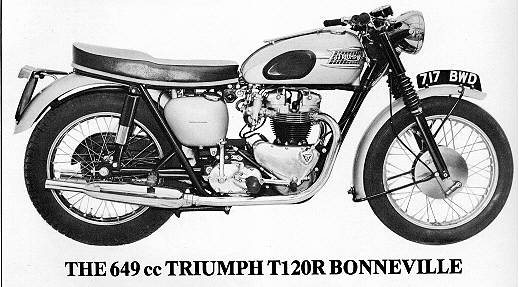
| Abundant vitality under all conditions is the keynote of the
Triumph "Bonnville 120." With exceptional topend performance goes extraordinary vigour and tractability
at low and medium engine speeds - a combination which makes it perhaps the fastest point-to-point
roasster produced in Britain today.
In London traffic it was one of the most pleasant machines we have ever used, thanks to its complete docility, reliable tick over and smart get-away. On the open road it had what has been aptly termed "explosive acceleration" and an ability to swallow mile after mile at the very highest cruising speeds. Some of the startling acceleration results from a lowish overall gear ratio - too low, actually, to give the optimum in sheer speed. When, under still-air conditions, this "650" flashed through MIRA's electronic trap at 108.2 mph, the rev-counter showed that the motor had run on past its peak power. So the speed-merchant could get even more knots by cogging up a shade. But if road work were his aim he would be ill-advised, for the top gear in use greatly assisted maintenance of speed under adverse conditions, aided acceleration and was a good all-round ratio. Consistent performance
|
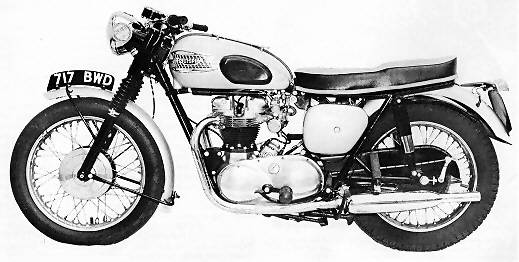
|
Vibration was not absent, but was never excessive. There were no "periods" and the back groung tremors were always within the rider's tolerance. Curiously, although the left footrest became quite "tingly" above a speedometer 90 in top and pro rata in the gears, that on the right was hardly affected. The current "120" has twin Amal "Monobloc" carburoters. each with its own float chamber, and automatic ignition control. In this trim it was almost incredibly docile for a machine of its type. Asked for sheer performance, the "120" gives a quick answer. Stir it up in the gears without a secure grip on the bars, and one has to shut down hastily and get back onto the front of the dual seat. The motor, we were told, was "safe" up to 7,500 rpm, but one took it up to these revs only when hustling towards a downhill maximum in top. In the gears, change-up revs were entirely the choice of the rider: we usually shifted at just over 6,000rpm when merely hurrying and nearer 7,000 when plotting the acceleration graph. Continued under graph details. |
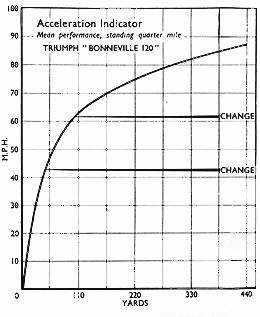
| Type Parrall twin four stroke.
Bore 71mm Stroke 82mm Capacity 649cc Valves Overhead pushrod Compression Ratio 8.5 :1 Carbs Twin Amal Monoblocs 1 -in bore Ignition Lucas K2F magneto with automatic control Generator Lucas RM15 6v alternator with full wave rectifier. Maker's claimed output 46 bhp at 6500 rpm Lubrication Plunger pumps Starting Kick, folding crank Transmission Separate gearbox with foot change Ratios 4.9 5.8 8.3 11.9 : 1 Speed at 1000 rpm in top gear: 16 mph Speed equivalent to revs at maximun power rating: Second Gear 61 mph Third Gear 88 mph Top Gear 106mph. Primary Drive Single row chain Secondary Drive Single row chain Clutch Multi plate in oil bath. Shock Absorber Rubber pad type in clutch. Cycle Parts Frame: Brazed cradle with twin front down tubes. Front Suspension Telescopic with coil springs and two way hydraulic damping. Rear Suspension Swinging fork with two Girling adjustable three position hydraulically damped spring units. Wheel Base 55inch. Tyres Dunlop 3.25 x 19in ribbed front. 4.00 x 18in studded rear Brakes 8in dia.front, 7in dia. rear. Total lining area 32 1/2 sq. in. Fuel Tank Welded steel, twin lever type taps. Oil Tank 5 pints Lamps 30/24w. head, 3w pilot, 18/6w stop/tail, 1.8w speedo & tacho. Battery Lucas 6v 13a.h. The "Bonneville" would always surge away again on engaging the higher cog.
|
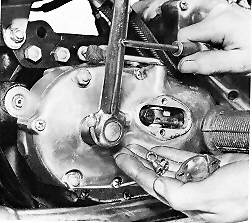
| The clutch plates parted at the first jab and bottom gear went in quietly from cold. But its engagement
became noisy when the unit was hot.
Tick over was always 100% reliable, slow and consistently "on two", a condition not always forthcoming from twin carby layouts. The adjusters to the throttle cables were conveniently accessible but not needed. despite so much hard throttle and fast cruising, the Bonneville returned a remarkable 64 mpg overall. The 122mpg/30 mph figure is fantastically good, yet there was never sign of weakness or hesitancy in the carburation and the plugs came out a good colour. They were removed only for inspection and were put back without either cleaning or re gapping, Oil consumption could not be accurately checked because of leakage past the tank cap at speed, but the engine itself appeared to be using none. The clutch was light in action, beautifully sweet and obeyed orders exactly. To this component must go
a due proportion of the praise for searing sprint starts.
Around the 100 mark on straight but bumpy roads called for concentration by the rider.
On the billiard-table smooth bowl of MIRA, however, the "120" was completely sure-footed at
ceiling speed. The springing was tremendously comfortable for a sportster.
|
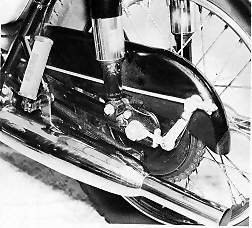
| Deeply valanced chain guard, drarbolts for spindle positioning, and external hairpin return spring on the
brake cam arm supplementing the internal pull off springs
Lights on the test mount were below par for this widely used Lucas equipment. We suspect that 717 BWD had a
poor block-lens light-unit. The horn, located under the saddle, was nearly audible to the rider, but it did seem
to have some affect on pedestrians.
Centre and prop stands were easy to use and gave good support. Every control, instrument and switch was excellently placed and contributed in its small way to making this machine such a pleasure to test. Truly difficult to fault, the Bonnville is an object lesson in how a motorcycle should be engineered. It not only passed the test routine with flying colours. but enabled saffmen to get some extremely high point- to- point averages on urgent Press assignments without fatigue or saddle soreness. We are happy to know that the machine will be coming back to us for a further test report when fitted with the optional high-speed equipment available from the factory. |